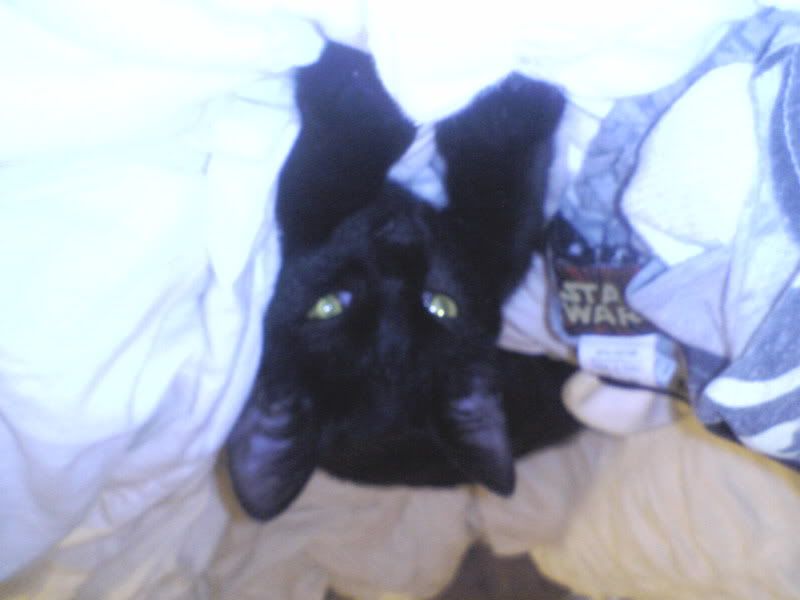I have had a house cat for 5 years. She is up to date on all her vaccinations etc. I will be adopting a stray kitten (kinda inbetween kitten and young adult) on Friday that some friends found. I want to be sure that when I put these two together that the stray doesn't infect my house cat with any diseases/germs etc.
I called one vet and asked what vaccinations I would need done and how soon could I safely put the two cats together. I was told an exam and 5 vaccinations would be necessary. They also said something like the stray would have to be 'boostered' 3 weeks later and it would not be safe to introduce them to each other until after the three weeks.
I called a DIFFERENT vet and asked the same question and I was told that the stray would of course need an exam and different vaccines etc. They didn't mention anything about bringing the stray back in 3 weeks later to be 'boostered'. I asked how soon I would be able to introduce the stray to my house cat and they said that as long as there was 'no upper respiratory stuff going on' and if the results from the tests they would do cleared (which they said they'd have results in 10 minutes) it would be okay to introduce them immediately.
I am very confused right now. I fear for the safety of my house cat. I have one vet telling me 3 weeks after bringing the stray in to the vet and the other vet saying if all is well immediately after bringing him in.
Why am I getting two completely different answers? What is safe and what should I do?
BTW both cats will be indoor cats.
Safety issues with bringing home a stray to my house cat!
-
dicklaurent
- Posts: 3
- Joined: Wed Dec 19, 2007 6:11 pm
- Location: Roseville, CA
- Contact:
Try to avoid the first vet. The second vet is iffy, but it could be simply whomever answered the phone failed to tell you kitty WILL need boosters. Did you call the vet you take YOUR cat to?
Exactly what vaccinations is YOUR cat up-to-date with? FVRCP? FELV? Rabies?
Get the new kitty to the vet immediately for an exam, testing for FELV/FIV (this takes 10 minutes using a snap test), and if it is negative, then vaccinate for FVRCP, FELV, and Rabies, and deworming. Depending on the age of the new kitty will depend on how many boosters she should get. A kitten less than a year old should get 1 FVRCP (and then 2 boosters), 1 FELV (and then 1 booster), and one Rabies (1-yr). After a year of age, providing boosters have been given, then the FVRCP and Rabies can be given every three years. Rabies may need to be annual or every-three years, depending on the cat, and your vet's policies. The FELV can be given annually, but depending on the risk factors/environment for the cat(s), the FELV annual could maybe be omitted (providing there are NO risk factors, the vet can explain that to you).
Each vaccine should be given 3-4 weeks apart, seperately if possible, but most cats tolerate at least two vaccines given together (like FVRCP and FELV done on same day).
It can take 7-10 days and beyond for most vaccines to provide immunity (but is only partial, that's why boosters are necessary)....if kitty is otherwise in excellent health, tests negative for FELV/FIV, and has no upper respiratory infection, then get her examined and vaccinated and dewormed BEFORE allowing contact between her and your other cat.
If there is an active infection in the new kitty, then waiting until the infection has cleared will help prevent your current cat from getting it. However, if your current cat is truly up-to-date on FVRCP, FELV and Rabies (and had boosters), then she is probably well protected. Upper respiratory infections can be easily transmitted between any cat, of any age and health status, but those with good vaccine histories and are in good health are better protected and symptoms may only be mild if that cat catches an upper respiratory infection. The infected cat however, needs treatment by the vet.
Exactly what vaccinations is YOUR cat up-to-date with? FVRCP? FELV? Rabies?
Get the new kitty to the vet immediately for an exam, testing for FELV/FIV (this takes 10 minutes using a snap test), and if it is negative, then vaccinate for FVRCP, FELV, and Rabies, and deworming. Depending on the age of the new kitty will depend on how many boosters she should get. A kitten less than a year old should get 1 FVRCP (and then 2 boosters), 1 FELV (and then 1 booster), and one Rabies (1-yr). After a year of age, providing boosters have been given, then the FVRCP and Rabies can be given every three years. Rabies may need to be annual or every-three years, depending on the cat, and your vet's policies. The FELV can be given annually, but depending on the risk factors/environment for the cat(s), the FELV annual could maybe be omitted (providing there are NO risk factors, the vet can explain that to you).
Each vaccine should be given 3-4 weeks apart, seperately if possible, but most cats tolerate at least two vaccines given together (like FVRCP and FELV done on same day).
It can take 7-10 days and beyond for most vaccines to provide immunity (but is only partial, that's why boosters are necessary)....if kitty is otherwise in excellent health, tests negative for FELV/FIV, and has no upper respiratory infection, then get her examined and vaccinated and dewormed BEFORE allowing contact between her and your other cat.
If there is an active infection in the new kitty, then waiting until the infection has cleared will help prevent your current cat from getting it. However, if your current cat is truly up-to-date on FVRCP, FELV and Rabies (and had boosters), then she is probably well protected. Upper respiratory infections can be easily transmitted between any cat, of any age and health status, but those with good vaccine histories and are in good health are better protected and symptoms may only be mild if that cat catches an upper respiratory infection. The infected cat however, needs treatment by the vet.
..........Traci
-
dicklaurent
- Posts: 3
- Joined: Wed Dec 19, 2007 6:11 pm
- Location: Roseville, CA
- Contact:
Re: Safety issues with bringing home a stray to my house cat
I just talked to the girl I'm getting the kitty from and she said it appears he has a bit of a cold. She said that he sometimes gets a little green guk in his eyes and seems a bit sneezy. She said she's been on her sister (who is taking care of him) to get him to the vet but she's been 'too busy' and hasn't been able to. She also said that it seemed like the cold has been getting 'better' but that it hasn't completely gone away yet. He was first found outside in fairly cold weather. I'm guessing this might be a result from that.
When I bring him home Friday night I'll of course keep him seperated from my house cat until I can bring him into the vet Saturday morning. However, how cautious do I need to be as far as not getting my house cat infected with whatever he may have. Should I block up the crack in the door so they can't play the 'paw under the door' game yet? Should I wash my hands inbetween petting each cat? Could those symptoms be something serious?
When I bring him home Friday night I'll of course keep him seperated from my house cat until I can bring him into the vet Saturday morning. However, how cautious do I need to be as far as not getting my house cat infected with whatever he may have. Should I block up the crack in the door so they can't play the 'paw under the door' game yet? Should I wash my hands inbetween petting each cat? Could those symptoms be something serious?
Re: Safety issues with bringing home a stray to my house cat
Cats do not get "colds" like humans, and they don't get URI's from cold weather. It is a virus, species-specific.
It sounds like the kitty definately has a URI (upper respiratory infection), and it isn't going to go away on it's own. He needs to be checked immediately, tested for FELV/FIV, dewormed, etc. If he has a URI, vaccinations should NOT be given until the URI is treated successully. Antibiotics from the vet, sometimes eye ointment to treat conjunctivitis, proper diet, no stresses, etc are usually all that's needed to treat a URI, but it must be treated NOW.
Don't need to block under the door. DO wash your hands thoroughly between handling cats and between handling litterboxes and food dishes. DO change your shirt before/after entering the room with the new kitty, because viruses can be transferred that way. Do NOT allow the cats to touch noses or share food/water dishes, litterboxes, etc....until new kitty has been treated successfully for the URI, and until he's been tested/vaccinated.
It sounds like the kitty definately has a URI (upper respiratory infection), and it isn't going to go away on it's own. He needs to be checked immediately, tested for FELV/FIV, dewormed, etc. If he has a URI, vaccinations should NOT be given until the URI is treated successully. Antibiotics from the vet, sometimes eye ointment to treat conjunctivitis, proper diet, no stresses, etc are usually all that's needed to treat a URI, but it must be treated NOW.
Don't need to block under the door. DO wash your hands thoroughly between handling cats and between handling litterboxes and food dishes. DO change your shirt before/after entering the room with the new kitty, because viruses can be transferred that way. Do NOT allow the cats to touch noses or share food/water dishes, litterboxes, etc....until new kitty has been treated successfully for the URI, and until he's been tested/vaccinated.
..........Traci
-
dicklaurent
- Posts: 3
- Joined: Wed Dec 19, 2007 6:11 pm
- Location: Roseville, CA
- Contact:
Re: Safety issues with bringing home a stray to my house cat
Lil' Ze is fully recovered! Yeay!!


Re: Safety issues with bringing home a stray to my house cat
He is precious! But, he looks very young, not even 6 months old yet...could be the pic, but how old is he really?
Have you had him to your vet for treating the URI, dewormed, tested for FELV/FIV, and vaccinated yet?
Have you had him to your vet for treating the URI, dewormed, tested for FELV/FIV, and vaccinated yet?
..........Traci

